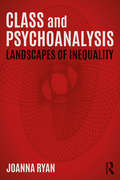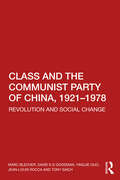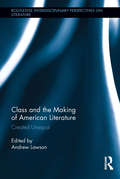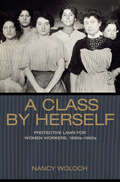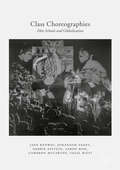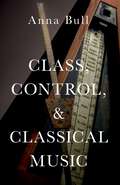- Table View
- List View
Class and Other Identities: Gender, Religion, and Ethnicity in the Writing of European Labour History (International Studies in Social History #2)
by Lex Heerma Van Voss Marcel Van Der LindenWith the onset of a more conservative political climate in the 1980s, social and especially labour history saw a decline in the popularity that they had enjoyed throughout the 1960s and 1970s. This led to much debate on its future and function within the historical discipline as a whole. Some critics declared it dead altogether. Others have proposed a change of direction and a more or less exclusive focus on images and texts. The most constructive proposals have suggested that labour history in the past concentrated too much on class and that other identities of working people should be taken into account to a larger extent than they had been previously, such as gender, religion, and ethnicity. Although class as a social category is still as valid as it has been before, the questions now to be asked are to what extent non-class identities shape working people's lives and mentalities and how these are linked with the class system. In this volume some of the leading European historians of labour and the working classes address these questions. Two non-European scholars comment on their findings from an Indian, resp. American, point of view. The volume is rounded off by a most useful bibliography of recent studies in European labour history, class, gender, religion, and ethnicity.
Class and Personality in Society
by Alan L. GreyThis volume graphically demonstrates how differences in social class affect personality. It does so by presenting research in class character covering a broad range of phenomena in the area shared by psychology, sociology, psychiatry, and anthropology. Concerned with key issues of substance and method in this area, the essays in Class and Personality in Society provide firsthand experience in the divergent ways in which specialists view and explore the relationship between personality and social status. The material offers a picture of how, out of controversy and confusion, scholars and researchers can achieve order, clarity, and sophistication. The editor's extensive introductory essay provides frames of reference from the social sciences pertinent to this aspect of social psychology. It describes historic trends and suggests fresh answers to controversial issues such as the nature of American class structure, the contribution of psychoanalysis to psychological research, and the relative importance, to personality, of early training versus current circumstance. Calling for more sociological awareness in psychological research, Grey documents his views with specific examples. The discussion is further enlivened by its pertinence to such current problems as the culture of poverty and community psychiatry. Class and Personality in Society was originally intended for use in courses in Social Psychology and Culture and Personality, and in sociology courses that discuss how social institutions and processes are related to individual personality. It may also provide stimulating supplemental reading in introductory psychology or sociology course. It will also prove valuable to professionals in specialized programs in clinical psychology and psychiatry concentrating on community mental health.
Class and Personality in Society
by Alan L. GreyThis volume graphically demonstrates how differences in social class affect personality. It does so by presenting research in class character covering a broad range of phenomena in the area shared by psychology, sociology, psychiatry, and anthropology. Concerned with key issues of substance and method in this area, the essays in Class and Personality in Society provide firsthand experience in the divergent ways in which specialists view and explore the relationship between personality and social status. The material offers a picture of how, out of controversy and confusion, scholars and researchers can achieve order, clarity, and sophistication. The editor's extensive introductory essay provides frames of reference from the social sciences pertinent to this aspect of social psychology. It describes historic trends and suggests fresh answers to controversial issues such as the nature of American class structure, the contribution of psychoanalysis to psychological research, and the relative importance, to personality, of early training versus current circumstance. Calling for more sociological awareness in psychological research, Grey documents his views with specific examples. The discussion is further enlivened by its pertinence to such current problems as the culture of poverty and community psychiatry. Class and Personality in Society was originally intended for use in courses in Social Psychology and Culture and Personality, and in sociology courses that discuss how social institutions and processes are related to individual personality. It may also provide stimulating supplemental reading in introductory psychology or sociology course. It will also prove valuable to professionals in specialized programs in clinical psychology and psychiatry concentrating on community mental health.
Class and Politics in Contemporary Social Science: Marxism Lite and Its Blind Spot for Culture
by Dick HoutmanDick Houtman argues that neither authoritarianism nor libertarianism can be explained by class or economic background, but rather by position in the cultural domain-- what he calls cultural capital. Although he examines all of the statistics and arguments of the conventional approaches with care and concern, Houtman convincingly demonstrates that the conclusions drawn from earlier studies are untenable at a more general theoretical level. Despite differences among advocates of class explanations, their theories are based on largely identical research findings--in particular a strong negative relationship between education and authoritarianism. Unobstructed by the conclusions these authors felt called upon to draw from the findings themselves, Houtman configures them in a new way. The hypotheses derived from this new theory allow for a systematic, strict, and competitive testing of original theses without ignoring the value of and earlier research. After demonstrating that authoritarianism and libertarianism cannot be explained by class or economic background, Houtman examines the implications of this argument for today's death of class debate in political sociology. He holds it to be unfortunate that the relevance of class to politics is typically addressed by studying the relation between class and voting. This conceals a complex cross-pressure mechanism that causes this relationship to capture the net balance of class voting and its opposite, cultural voting, instead of class voting. He argues that references to a decline in class voting may be basically correct, but dogmatic reliance on the relation between class and voting to prove the point systematically underestimates levels of class voting and produces an exaggerated picture of the decline.
Class and Politics in Contemporary Social Science: Marxism Lite and Its Blind Spot for Culture
by Dick HoutmanDick Houtman argues that neither authoritarianism nor libertarianism can be explained by class or economic background, but rather by position in the cultural domain-- what he calls cultural capital. Although he examines all of the statistics and arguments of the conventional approaches with care and concern, Houtman convincingly demonstrates that the conclusions drawn from earlier studies are untenable at a more general theoretical level. Despite differences among advocates of class explanations, their theories are based on largely identical research findings--in particular a strong negative relationship between education and authoritarianism. Unobstructed by the conclusions these authors felt called upon to draw from the findings themselves, Houtman configures them in a new way. The hypotheses derived from this new theory allow for a systematic, strict, and competitive testing of original theses without ignoring the value of and earlier research. After demonstrating that authoritarianism and libertarianism cannot be explained by class or economic background, Houtman examines the implications of this argument for today's death of class debate in political sociology. He holds it to be unfortunate that the relevance of class to politics is typically addressed by studying the relation between class and voting. This conceals a complex cross-pressure mechanism that causes this relationship to capture the net balance of class voting and its opposite, cultural voting, instead of class voting. He argues that references to a decline in class voting may be basically correct, but dogmatic reliance on the relation between class and voting to prove the point systematically underestimates levels of class voting and produces an exaggerated picture of the decline.
Class and Psychoanalysis: Landscapes of Inequality
by Joanna RyanDoes psychoanalysis have anything to say about the emotional landscapes of class? How can class-inclusive psychoanalytic projects, historic and contemporary, inform theory and practice? Class and psychoanalysis are unusual bedfellows, but this original book shows how much is to be gained by exploring their relationship. Joanna Ryan provides a comprehensively researched and challenging overview in which she holds the tension between the radical and progressive potential of psychoanalysis, in its unique understandings of the unconscious, with its status as a mainly expensive and exclusive profession. Class and Psychoanalysis draws on existing historical scholarship, as well as on the experiences of the author and other writers in free or low-cost projects, to show what has been learned from transposing psychoanalysis into different social contexts. The book describes how class, although descriptively present, was excluded from the founding theories of psychoanalysis, leaving a problematic conceptual legacy that the book attempts to remedy. Joanna Ryan argues for an interdisciplinary approach, drawing on modern sociological and psychosocial research to understand the injuries of class, the complexities of social mobility, and the defenses of privilege. She brings together contemporary clinical writings with her own research about class within therapy relationships to illustrate the anxieties, ambivalences and inhibitions surrounding class, and the unconsciousness with which it may be enacted. Class and Psychoanalysis breaks new ground in providing frameworks for a critical psychoanalysis that includes class. It will be of interest to anyone who wishes to think psychoanalytically about how we are intimately formed by class, or who is concerned with the inequalities of access to psychoanalytic therapies, or with the future of psychoanalysis.
Class and Psychoanalysis: Landscapes of Inequality
by Joanna RyanDoes psychoanalysis have anything to say about the emotional landscapes of class? How can class-inclusive psychoanalytic projects, historic and contemporary, inform theory and practice? Class and psychoanalysis are unusual bedfellows, but this original book shows how much is to be gained by exploring their relationship. Joanna Ryan provides a comprehensively researched and challenging overview in which she holds the tension between the radical and progressive potential of psychoanalysis, in its unique understandings of the unconscious, with its status as a mainly expensive and exclusive profession. Class and Psychoanalysis draws on existing historical scholarship, as well as on the experiences of the author and other writers in free or low-cost projects, to show what has been learned from transposing psychoanalysis into different social contexts. The book describes how class, although descriptively present, was excluded from the founding theories of psychoanalysis, leaving a problematic conceptual legacy that the book attempts to remedy. Joanna Ryan argues for an interdisciplinary approach, drawing on modern sociological and psychosocial research to understand the injuries of class, the complexities of social mobility, and the defenses of privilege. She brings together contemporary clinical writings with her own research about class within therapy relationships to illustrate the anxieties, ambivalences and inhibitions surrounding class, and the unconsciousness with which it may be enacted. Class and Psychoanalysis breaks new ground in providing frameworks for a critical psychoanalysis that includes class. It will be of interest to anyone who wishes to think psychoanalytically about how we are intimately formed by class, or who is concerned with the inequalities of access to psychoanalytic therapies, or with the future of psychoanalysis.
Class and Stratification
by Rosemary CromptonInequality in its many forms is becoming an ever greater problem in modern society. The revised edition of this popular book explains why it is so important to understand class and stratification, and how the tools used to analyse these divisions can help us to understand and confront problems of inequality. This third edition of Class and Stratification has been extensively revised, expanded and updated, incorporating discussions of contemporary economic and social change. It includes discussions of political and economic neoliberalism and its impacts as well as developments in social theory, such as the emphasis on 'individualization' and the 'cultural turn'. New to this edition is a chapter focusing on 'cultural' approaches to class analysis, which together with established approaches are used to explore new developments in social mobility, educational opportunity, and social polarization. The book will be essential reading for upper-level undergraduate and postgraduate students in the social sciences seeking to understand the changing face of social inequality. By highlighting the damage increasing inequality is causing to the social fabric, the book reveals the important part class continues to play in our lives today.
Class and Stratification Analysis (Comparative Social Research #30)
by Gunn Elisabeth Birkelund Fredrik EngelstadThis volume of "Comparative Social Research" emphasizes unsolved issues and new developments within class and stratification analysis, discussing both theoretical and methodological innovations and revisions. Studies of social stratification comprises a range of topics, such as social mobility, economic inequality, labor market inequalities, ethnic stratification, gender inequality, family patterns, educational attainment, and health inequality, the stratification of cultural consumption, life styles, values and attitudes. Comparative analysis has also revealed cross-national differentiation in stratification processes, partly related to welfare state arrangements and national policies. Yet all academic fields move forward, and with its vital research community social stratification research also engages in efforts to improve stratification analysis. This involves discussions on theoretical definitions and conceptual clarifications, social mechanisms and modeling techniques and measurements.
Class and the Communist Party of China, 1921-1978: Revolution and Social Change
by Marc Blecher David S Goodman Yingjie Guo Jean-Louis Rocca Tony SaichExamining the interaction between the Communist Party of China (CCP) and specific social categories (including peasants, workers, the middle classes, and the dominant class), with a focus on class and class discourse, this volume analyses the CCP’s impact on social change in China between 1921 and 1978. By exploring the CCP’s evolving discourse of class, this book demonstrates that, while class has retained its centrality, its meaning has been re-articulated from an ideological-political tool to a less meaningful signifier, though always used instrumentality. By examining the impact of the CCP’s policies and discourse surrounding class, it also reveals how its own policies since 1921 have shaped the CCP’s current (2021) perspectives on class and stratification. This volume, through an analysis of economic, political, and cultural inequalities in Chinese society even after 1949, also reveals the emergence of a diverse and often overlooked middle class in Chinese society during the 1950s. Delivering a detailed analysis of how the CCP has developed its practical approaches to class and mobilization, this study will be of interest to students and scholars of Chinese politics, Chinese history, Asian politics, and Asian studies.
Class and the Communist Party of China, 1921-1978: Revolution and Social Change
by Marc Blecher David S Goodman Yingjie Guo Jean-Louis Rocca Tony SaichExamining the interaction between the Communist Party of China (CCP) and specific social categories (including peasants, workers, the middle classes, and the dominant class), with a focus on class and class discourse, this volume analyses the CCP’s impact on social change in China between 1921 and 1978. By exploring the CCP’s evolving discourse of class, this book demonstrates that, while class has retained its centrality, its meaning has been re-articulated from an ideological-political tool to a less meaningful signifier, though always used instrumentality. By examining the impact of the CCP’s policies and discourse surrounding class, it also reveals how its own policies since 1921 have shaped the CCP’s current (2021) perspectives on class and stratification. This volume, through an analysis of economic, political, and cultural inequalities in Chinese society even after 1949, also reveals the emergence of a diverse and often overlooked middle class in Chinese society during the 1950s. Delivering a detailed analysis of how the CCP has developed its practical approaches to class and mobilization, this study will be of interest to students and scholars of Chinese politics, Chinese history, Asian politics, and Asian studies.
Class and the Making of American Literature: Created Unequal (Routledge Interdisciplinary Perspectives on Literature)
by Andrew LawsonThis book refocuses current understandings of American Literature from the revolutionary period to the present-day through an analytical accounting of class, reestablishing a foundation for discussions of class in American culture. American Studies scholars have explored the ways in which American society operates through inequality and modes of social control, focusing primarily on issues of status group identities involving race/ethnicity, gender, sexuality, and disability. The essays in this volume focus on both the historically changing experience of class and its continuing hold on American life. The collection visits popular as well as canonical literature, recognizing that class is constructed in and mediated by the affective and the sensational. It analyzes class division, class difference, and class identity in American culture, enabling readers to grasp why class matters, as well as the economic, social, and political matter of class. Redefining the field of American literary cultural studies and asking it to rethink its preoccupation with race and gender as primary determinants of identity, contributors explore the disciplining of the laboring body and of the emotions, the political role of the novel in contesting the limits of class power and authority, and the role of the modern consumer culture in both blurring and sharpening class divisions.
Class and the Making of American Literature: Created Unequal (Routledge Interdisciplinary Perspectives on Literature)
by Andrew LawsonThis book refocuses current understandings of American Literature from the revolutionary period to the present-day through an analytical accounting of class, reestablishing a foundation for discussions of class in American culture. American Studies scholars have explored the ways in which American society operates through inequality and modes of social control, focusing primarily on issues of status group identities involving race/ethnicity, gender, sexuality, and disability. The essays in this volume focus on both the historically changing experience of class and its continuing hold on American life. The collection visits popular as well as canonical literature, recognizing that class is constructed in and mediated by the affective and the sensational. It analyzes class division, class difference, and class identity in American culture, enabling readers to grasp why class matters, as well as the economic, social, and political matter of class. Redefining the field of American literary cultural studies and asking it to rethink its preoccupation with race and gender as primary determinants of identity, contributors explore the disciplining of the laboring body and of the emotions, the political role of the novel in contesting the limits of class power and authority, and the role of the modern consumer culture in both blurring and sharpening class divisions.
Class and the Uses of Poetry: Symbolic Enclosures (Sociology of the Arts)
by Andrew SmithThis book provides new empirical evidence about the ways in which social inequalities, especially those of class, shape and delimit forms of cultural reception and creative opportunity. How does it come about that, in George Orwell’s words, ‘the divorce between poetry and popular culture is accepted as a sort of law of nature’? Drawing on qualitative research conducted in and around Glasgow, Poetry, Class and Symbolic Violence explores how working-class readers engaged with, made sense of, and contested a sense of exclusion from, contemporary poetry. In doing so it sheds light on the symbolic enclosure of poetry, on how that enclosure takes shape in the encounter between readers and poems, but also on why poetry continues to matter. Through these conversations, and in further interviews with unpublished poets, it reflects on the creative and expressive affordances of poetry, on what can be done with poetry and what it can make possible. Sociologists have had little to say about poetry as a distinctive esthetic practice. Poetry, Class and Symbolic Violence tries to break that silence and to make a start on constructing a critical sociology of poetry for today.
A Class by Herself: Protective Laws for Women Workers, 1890s–1990s
by Nancy WolochA Class by Herself explores the historical role and influence of protective legislation for American women workers, both as a step toward modern labor standards and as a barrier to equal rights. Spanning the twentieth century, the book tracks the rise and fall of women-only state protective laws—such as maximum hour laws, minimum wage laws, and night work laws—from their roots in progressive reform through the passage of New Deal labor law to the feminist attack on single-sex protective laws in the 1960s and 1970s.Nancy Woloch considers the network of institutions that promoted women-only protective laws, such as the National Consumers' League and the federal Women's Bureau; the global context in which the laws arose; the challenges that proponents faced; the rationales they espoused; the opposition that evolved; the impact of protective laws in ever-changing circumstances; and their dismantling in the wake of Title VII of the Civil Rights Act of 1964. Above all, Woloch examines the constitutional conversation that the laws provoked—the debates that arose in the courts and in the women's movement. Protective laws set precedents that led to the Fair Labor Standards Act of 1938 and to current labor law; they also sustained a tradition of gendered law that abridged citizenship and impeded equality for much of the century.Drawing on decades of scholarship, institutional and legal records, and personal accounts, A Class by Herself sets forth a new narrative about the tensions inherent in women-only protective labor laws and their consequences.
A Class by Herself: Protective Laws for Women Workers, 1890s–1990s (PDF)
by Nancy WolochA Class by Herself explores the historical role and influence of protective legislation for American women workers, both as a step toward modern labor standards and as a barrier to equal rights. Spanning the twentieth century, the book tracks the rise and fall of women-only state protective laws—such as maximum hour laws, minimum wage laws, and night work laws—from their roots in progressive reform through the passage of New Deal labor law to the feminist attack on single-sex protective laws in the 1960s and 1970s.Nancy Woloch considers the network of institutions that promoted women-only protective laws, such as the National Consumers' League and the federal Women's Bureau; the global context in which the laws arose; the challenges that proponents faced; the rationales they espoused; the opposition that evolved; the impact of protective laws in ever-changing circumstances; and their dismantling in the wake of Title VII of the Civil Rights Act of 1964. Above all, Woloch examines the constitutional conversation that the laws provoked—the debates that arose in the courts and in the women's movement. Protective laws set precedents that led to the Fair Labor Standards Act of 1938 and to current labor law; they also sustained a tradition of gendered law that abridged citizenship and impeded equality for much of the century.Drawing on decades of scholarship, institutional and legal records, and personal accounts, A Class by Herself sets forth a new narrative about the tensions inherent in women-only protective labor laws and their consequences.
Class, Caste and Color: A Social and Economic History of the South African Western Cape
by Wilmot JamesThis volume is the first general social and economic history of the Western Cape of South Africa. Until recently, this region had been largely neglected by historians because it does not occupy a central place in the national political economy. Wilmot G. James and Mary Simons argue that a great deal about modern South Africa has been shaped by the distinctive society and economy of the Western Cape. Its history also reveals striking parallels and contrasts with other regions of the African continent.The Western Cape is the only region of South Africa to have experienced slavery. In this sense, the Western Cape has historical traditions more akin to colonial slave societies of the Americas than to those of the rest of Africa. Moreover, in contrast to the rest of South Africa, a proletariat emerged in the Western Cape early in its history, at the start of the eighteenth century. There developed a much more stable and enduring system of class and labor relations. In the twentieth century, these became closely enmeshed with race and status. Racial paternalism and the close correlation between class, caste, and color have their historical roots in the Western Cape.The book is arranged thematically and explores the social and economic consequences of slavery and emancipation in the eighteenth and nineteenth centuries. Issues of economy and labor, such as economic underdevelopment in the Western Cape, the labor market, and trade-union organization in the twentieth century are examined. The authors also treat the role of the state in shaping Western Cape society. Class, Caste, and Color is not only a groundbreaking work in the study of South Africa, but provides an agenda for future researchers. It will be essential reading for historians, economists, and Africa area specialists.
Class, Caste and Color: A Social and Economic History of the South African Western Cape
by Wilmot G. James Mary SimonsThis volume is the first general social and economic history of the Western Cape of South Africa. Until recently, this region had been largely neglected by historians because it does not occupy a central place in the national political economy. Wilmot G. James and Mary Simons argue that a great deal about modern South Africa has been shaped by the distinctive society and economy of the Western Cape. Its history also reveals striking parallels and contrasts with other regions of the African continent.The Western Cape is the only region of South Africa to have experienced slavery. In this sense, the Western Cape has historical traditions more akin to colonial slave societies of the Americas than to those of the rest of Africa. Moreover, in contrast to the rest of South Africa, a proletariat emerged in the Western Cape early in its history, at the start of the eighteenth century. There developed a much more stable and enduring system of class and labor relations. In the twentieth century, these became closely enmeshed with race and status. Racial paternalism and the close correlation between class, caste, and color have their historical roots in the Western Cape.The book is arranged thematically and explores the social and economic consequences of slavery and emancipation in the eighteenth and nineteenth centuries. Issues of economy and labor, such as economic underdevelopment in the Western Cape, the labor market, and trade-union organization in the twentieth century are examined. The authors also treat the role of the state in shaping Western Cape society. Class, Caste, and Color is not only a groundbreaking work in the study of South Africa, but provides an agenda for future researchers. It will be essential reading for historians, economists, and Africa area specialists.
The class ceiling: Why it pays to be privileged
by Sam Friedman Daniel LaurisonPoliticians continually tell us that anyone can get ahead. But is that really true? This important book takes readers behind the closed doors of elite employers to reveal how class affects who gets to the top. Friedman and Laurison show that a powerful ‘class pay gap’ exists in Britain’s elite occupations. Even when those from working-class backgrounds make it into prestigious jobs, they earn, on average, 16% less than colleagues from privileged backgrounds. But why is this the case? . Drawing on 200 interviews across four case studies - television, accountancy, architecture, and acting – they explore the complex barriers facing the upwardly mobile. This is a rich, ambitious book that demands we take seriously not just the glass but also the class ceiling.
The class ceiling: Why it pays to be privileged
by Sam Friedman Daniel LaurisonPoliticians continually tell us that anyone can get ahead. But is that really true? This important book takes readers behind the closed doors of elite employers to reveal how class affects who gets to the top. Friedman and Laurison show that a powerful ‘class pay gap’ exists in Britain’s elite occupations. Even when those from working-class backgrounds make it into prestigious jobs, they earn, on average, 16% less than colleagues from privileged backgrounds. But why is this the case? . Drawing on 200 interviews across four case studies - television, accountancy, architecture, and acting – they explore the complex barriers facing the upwardly mobile. This is a rich, ambitious book that demands we take seriously not just the glass but also the class ceiling.
Class Choreographies: Elite Schools and Globalization
by Jane Kenway Johannah Fahey Debbie Epstein Aaron Koh Cameron McCarthy Fazal RizviAwarded Best Book prize by CIES Globalization and Education SIGAwarded 2nd Prize in the Society of Educational Studies Annual Book PrizeElite schools have always been social choreographers par excellence. The world over, they put together highly dexterous performances as they stage and restage changing relations of ruling. They are adept at aligning their social choreographies to shifting historical conditions and cultural tastes. In multiple theatres, they now regularly rehearse the irregular art of being global. Elite schools around the world are positioned at the intersecting pinnacles of various scales, systems and regimes of social, cultural, political and economic power. They have much in common but are also diverse. They illustrate how various modalities of power are enjoyed and put to work and how educational and social inequalities are shaped and shifted. They, thus, speak to the social zeitgeist. Thisbook dissects this intricate choreography.
Class Conflict and Modernization in India: The Raj and the Calcutta Waterfront (1860-1910) (Routledge Studies in South Asian History)
by Aniruddha BoseIn the days of the British Raj Calcutta was a great port city. Thousands of men, women, and children worked there, loading and unloading valuable cargoes that sustained the regional economy, and contributed significantly to world trade. In the second half of the nineteenth century, in response to a shift from sailing ships to steamers, port authorities in Calcutta began work on a massive modernization project. This book is the first study of port labor in colonial Calcutta and British India. Drawing on primary source material, including government documents and newspaper records, the author demonstrates how the modernization process worsened class conflict and highlights the important part played by labor in the shaping of the port’s modernization. Class Conflict and Modernization in India places this history in a comparative context, highlighting the interconnected nature of port and port labor histories. It examines how the port’s modernization affected the port workforce and the port’s managers, as well as the impact on class formation that emerged as labourers resisted through acts of everyday resistance and organized strikes. A detailed study of state power, technological change, and class conflict, this book will be of interest to academics of modern Indian history, labour history and the history of science and technology.
Class Conflict and Modernization in India: The Raj and the Calcutta Waterfront (1860-1910) (Routledge Studies in South Asian History)
by Aniruddha BoseIn the days of the British Raj Calcutta was a great port city. Thousands of men, women, and children worked there, loading and unloading valuable cargoes that sustained the regional economy, and contributed significantly to world trade. In the second half of the nineteenth century, in response to a shift from sailing ships to steamers, port authorities in Calcutta began work on a massive modernization project. This book is the first study of port labor in colonial Calcutta and British India. Drawing on primary source material, including government documents and newspaper records, the author demonstrates how the modernization process worsened class conflict and highlights the important part played by labor in the shaping of the port’s modernization. Class Conflict and Modernization in India places this history in a comparative context, highlighting the interconnected nature of port and port labor histories. It examines how the port’s modernization affected the port workforce and the port’s managers, as well as the impact on class formation that emerged as labourers resisted through acts of everyday resistance and organized strikes. A detailed study of state power, technological change, and class conflict, this book will be of interest to academics of modern Indian history, labour history and the history of science and technology.
Class, Contention, and a World in Motion (Dislocations #8)
by Winnie Lem and Pauline Gardiner BarberPrevailing scholarship on migration tends to present migrants as the objects of history, subjected to abstract global forces or to concrete forms of regulation imposed by state and supra state organizations. In this volume, by contrast, the focus is on migrants as the subjects of history who not only react but also act to engage with and transform their worlds. Using ethnographic examples from Africa, Asia, Europe, North America and the Middle East, contributors question how and why particular forms of political struggle and collective action may, or indeed may not, be carried forward in the context of geographic and social border crossings. In doing so, they bring the dynamic relationship between class, gender, and culture to the forefront in each distinctive migration setting.
Class, Control, and Classical Music
by Anna BullWhy is classical music predominantly the preserve of the white middle classes? Contemporary associations between classical music and social class remain underexplored, with classical music primarily studied as a text rather than as a practice until recent years. In order to answer this question, this book outlines a new approach for a socio-cultural analysis of classical music, asking how musical institutions, practices, and aesthetics are shaped by wider conditions of economic inequality, and how music might enable and entrench such inequalities or work against them. This approach is put into practice through a richly detailed ethnography which locates classical music within one of the cultures that produces it - middle-class English youth - and foregrounds classical music as bodily practice of control and restraint. Drawing on the author's own background as a classical musician, this closely observed account examines youth orchestra and youth choir rehearsals as a space where young people learn the unspoken rules of this culture of weighty tradition and gendered control. It highlights how the middle-classes' habitual roles - boundary drawing around their protected spaces and reproducing their privilege through education - can be traced within the everyday spaces of classical music. These practices are camouflaged, however, by the ideology of 'autonomous art' that classical music carries. Rather than solely examining the social relations around the music, the book demonstrates how this reproductive work is facilitated by its very aesthetic, of 'controlled excitement', 'getting it right', precision, and detail. This book is of particular interest at the present moment, thanks to the worldwide proliferation of El Sistema-inspired programmes which teach classical music to children in underserved areas. While such schemes demonstrate a resurgence in defending the value of classical music, there has been a lack of debate over the ways in which its socio-cultural heritage shapes its conventions today. This book locates these contestations within contemporary debates on class, gender and whiteness, making visible what is at stake in such programmes.



